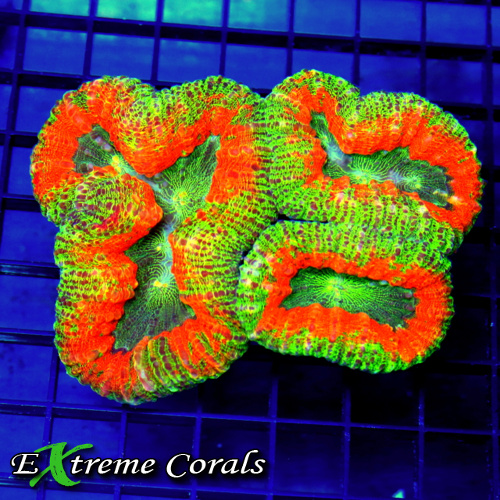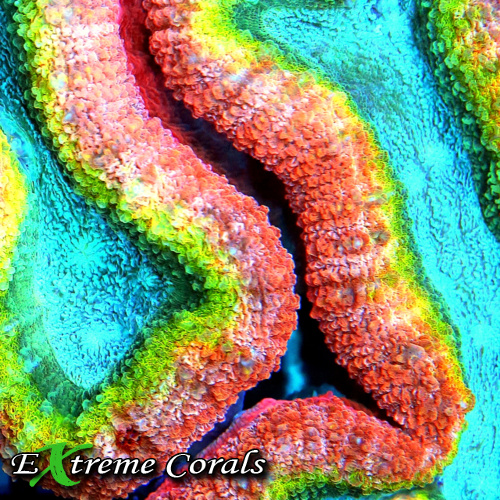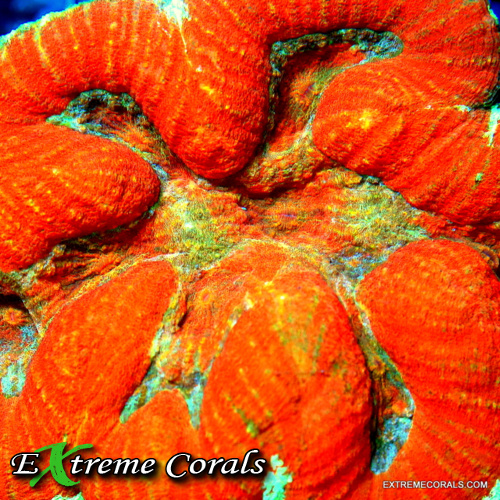Extreme Corals News and Updates
The Fascinating World of Lobophyllia Corals: Care, Colors, and Compatibility
Explore the care, colors, and compatibility of lobophyllia corals in our captivating blog, 'The Fascinating World of Lobophyllia Corals: Care, Colors, and Compatibility'.
Lobophyllia corals, also known as Lobos, are prized by enthusiasts for their vibrant colors and unique patterns, making them a beautiful addition to reef tanks. These hardy Large Polyp Stony (LPS) corals thrive in well-maintained aquariums with moderate to high lighting and water flow. Proper care, including regular feeding, maintaining stable water parameters, and ensuring compatibility with other tank inhabitants, is essential for their health and longevity.
by scott Shiles • May 20, 2024
Introduction to Lobophyllia Corals

Lobophyllia corals, also known as "Lobos," are sought-after by many coral enthusiasts for their vibrant colors and unique patterns. These corals belong to the LPS (Large Polyp Stony) coral group and are known for their exotic beauty. Lobos are relatively hardy and can thrive in a well-maintained aquarium environment. They are generally peaceful and can coexist with a variety of tank mates, making them an excellent addition to a reef tank. These corals require moderate to high lighting and water flow to flourish, and proper care and maintenance are essential to ensure their health and longevity.
Care Tips for Lobophyllia Corals
Lobophyllia corals require moderate to high lighting and moderate water flow to thrive. It's essential to maintain stable water parameters, including temperature, salinity, and pH levels. Regular water changes are crucial for keeping them healthy. Feeding them with small foods like zooplankton can promote growth. Be cautious not to place these corals too close to aggressive tank mates, as they can be sensitive to stings from other corals.
Understanding the Colors of Lobophyllia Corals

Lobophyllia corals come in a stunning array of colors, ranging from vibrant reds, greens, blues, purples, and even neon hues. These colors are a result of the symbiotic relationship between the coral and the algae living within its tissues. The varying hues can indicate the health of the coral, as brighter colors often signify a thriving and well-maintained specimen. By understanding the colors of Lobophyllia corals, you can better appreciate their beauty and ensure they are flourishing in your aquarium.
Compatibility of Lobophyllia Corals with Other Species
Lobophyllia corals, also known as Lobo corals, are generally peaceful tank members. They can easily coexist with a variety of fish, invertebrates, and other coral species in a well-maintained reef aquarium. However, certain precautions should be taken to ensure the harmony within your aquarium ecosystem. Here are some points to consider:
Lobophyllia corals should be placed away from aggressive coral species to prevent territorial conflicts.
Regular monitoring of water parameters is essential to maintain optimal conditions for both Lobophyllia corals and other tank inhabitants.
Proper spacing between coral colonies can help prevent overcrowding and potential aggression between species.
Introducing new tank mates gradually allows all species to adjust and reduces stress in the environment.
By carefully considering the compatibility of Lobophyllia corals with other species and providing a well-balanced habitat, you can create a thriving and visually captivating aquarium ecosystem.
Ideal Tank Conditions for Lobophyllia Corals

Lobophyllia corals thrive in saltwater tanks with a stable temperature between 75-82°F. They prefer moderate to high lighting levels, ideally around PAR 200-350. Ensure a pH level of 8.1-8.4 and a specific gravity of 1.023-1.025. Regular water changes and maintaining proper calcium, alkalinity, and magnesium levels are crucial for their health. Avoid high nutrient levels as they can negatively affect Lobophyllia corals.
Common Issues and How to Address Them
If you notice your Lobophyllia corals showing signs of discoloration, it could be due to inadequate lighting or poor water quality. To address this issue, consider adjusting the placement of your coral to a spot with appropriate lighting and ensure your tank parameters are within the recommended range. Additionally, if your coral is not extending its tentacles or appears unhealthy, it may be experiencing stress. Perform a water test to check for any imbalances and consider implementing a water change to help improve the overall water quality.
Feeding Lobophyllia Corals

Lobophyllia corals are generally easy to care for and do not require frequent feeding. Feeding them once or twice a week with small food particles like plankton or special coral food is sufficient to keep them healthy. Overfeeding can lead to water quality issues, so it's essential to regulate their feeding to maintain a balanced aquarium environment.
Propagation and Fragging Techniques
Lobophyllia corals can be propagated through fragging, which involves carefully cutting a piece of the coral. The cutting is then attached to a new substrate where it can grow into a new coral colony. Fragging is commonly used to create multiple colonies from a single coral, to trade or sell corals, or to rejuvenate an older colony. When fragging Lobophyllia corals, it's essential to use sterile tools to prevent infections and to ensure the health of the new colonies.
Enhancing Growth and Health of Lobophyllia Corals
To enhance the growth and health of your Lobophyllia corals, ensure they receive adequate lighting, preferably moderate to high intensity. Provide stable water conditions with proper temperature, pH levels, and salinity. Regularly feed your corals with suitable foods like zooplankton or phytoplankton. Avoid placing them too close to aggressive corals to prevent damage. Maintain good water flow around the corals to prevent detritus buildup. Monitor their color and expansion daily for signs of stress or disease.
Summary and Key Takeaway
Lobophyllia corals come in a variety of vibrant colors and can thrive in different tank environments as long as they receive proper care. Key takeaways include maintaining stable water parameters, providing adequate lighting, and regular feeding to ensure the health and growth of these corals. Remember to consider the compatibility of Lobophyllia corals with other species in your aquarium to prevent any conflicts or harm to your marine ecos

